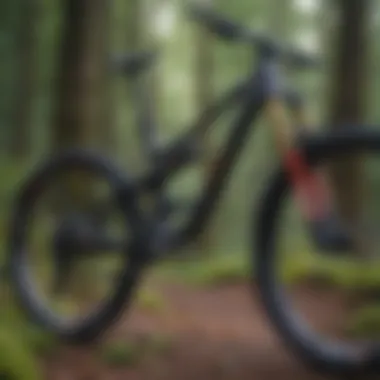Trail vs Cross Country Mountain Bikes: Key Differences


Intro
This article aims to dissect the nuances between trail and cross-country mountain bikes. As mountain biking gains traction, understanding the distinction between these two prominent categories becomes crucial. Both types of bikes serve unique riding styles and specific terrain adaptability, making them ideal for varying enthusiasts. The ensuing discussion brings to light essential features, including geometry, suspension systems, and overall weight considerations.
Having knowledge about the differences in bikes reinforces informed choices, directly enhancing the riding experience based on personal preference. Understanding how these bikes are designed opens up opportunities to enjoy one's biking endeavors to the fullest.
Equipment and Gear
When it comes to mountain biking, adequate equipment and gear can enhance your overall performance and safety. Both trail and cross-country biking require essential accessories, yet specific needs may vary.
Overview of Essential Gear
The basic gear for mountain biking usually consists of:
- Helmet: A high-quality helmet protects your head, ensuring safety in unexpected accidents.
- Gloves: They provide grip and reduce hand fatigue on lengthy rides.
- Footwear: Proper mountain biking shoes can improve pedal efficiency and comfort.
- Clothing: Wear moisture-wicking and durable clothing suitable for tough terrains and varied weather.
Detailed Descriptions of Top Brands
Opt for reputable brands that offer good reliability and performance:
- Bell Helmets: Known for advanced safety features and comfortable fit.
- Shimano Shoes: Recognized for excellent grip and durability, perfect for rigorous riding.
- Fox Racing Gear: Offers a wide range of biking jerseys and shorts designed to withstand rugged conditions.
Tips on Maintenance and Upgrades
Maintaining your mountain bike is essential for prolonging its life and performance. Regular practices include:
- Keep the bike clean to avoid mud and grime buildup.
- Inspect the suspension system periodically; it affects ride quality.
- Upgrade components like tires and grips to enhance performance over time.
Familiarizing oneself with new advancements in biking technology can augment your riding experience.
Summary
Taking gear seriously in trail or cross-country biking makes a significant difference, impacting not only performance but also overall enjoyment. The information discussed herein will prepare riders for the terrain ahead, albeit in varying conditions, offering both safety and pleasure in exhilarating rides.
Prelims to Mountain Biking
Mountain biking has grown increasingly popular. It offers a thrilling way to experience nature while engaging in rigorous physical activity. This article aims to demystify the differences between trail and cross-country mountain bikes, illuminating their unique characteristics and helping riders make informed choices. Comprehending these distinctions influences riding styles, experiences, and performance outcomes.
Definition of Mountain Biking
Mountain biking is an outdoor activity that combines cycling with adventurous terrains. It is not limited to just the bike, but includes the environment. Specific trails, hills, vegetation, and elevation come into play. Riders utilize specialized bikes meant for rougher ground. They rise to overcome barriers posed by roots, rocks, and steep hills. Therefore, mountain biking is akin to utilizing both athletic abilities and an understanding of varied landscapes. Intentionally designed bicycles facilitate proper performance and rider comfort even in challenging conditions.
The Evolution of Mountain Biking
The inception of mountain biking is rooted in adapting traditional bicycles for unpaved paths. Initially, in the late 1970s, cyclists began modifying their road bikes. These modifications included wider tires, sturdier frames, and gearing designed for challenging ascents. This trend culminated in the birth of dedicated mountain bikes that symbolize the current sport.
Over the years, advancements in technology dynamcially reshaped mountain biking. Manufacturers invested considerable effort to enhance material strength and riding flexibility. Carbon fiber and aluminum emerged as lightweight yet robust frame materials. These innovations improved bike performance vastly.
Today, standards incorporate various designs to cater to specific riding styles—trail, cross-country, downhill, and hair-raising enduro events. The choice of bike directly affects how cyclists experience diverse landscapes. What was once a simple modification led to an entire industry based on the pursuit of riding in nature. The evolution symbolizes an ongoing relationship between bicycles and riders with the natural world. As mountain biking matures, much less the way it harmonizes fitness and adventure attitudes remains evident.
What is Trail Mountain Biking?
Trail mountain biking is a vital segment in the outdoor cycling community, offering a unique blend of adventure and technical skills. This discipline emphasizes rides across varying terrains, from smooth dirt paths to rugged trails. Understanding trail biking is essential for riders who seek an all-around experience, where navigating steep descents and climbing inclines become essential skills. The community surrounding trail biking also values the connection with nature and the thrill of exploration.
Overview of Trail Bikes


Trail bikes are specially designed for versatility. These bikes bridge the gap between cross-country models and downhill bikes. They are generally capable of handling diverse types of terrain while offering a smooth ride. Riders enjoy trail bikes for their ability to descend effectively without compromising too much on climbing performance. This makes them suitable for various terrains which enhances their appeal among many cyclists.
Key Features of Trail Bikes
Frame Geometry
Frame geometry is crucial for performance in trail riding. Trail bikes typically have a longer wheelbase and slacker head angle compared to cross-country bikes. This configuration improves stability during downhill descending and provides better control in technical sections. Riders like the balance it brings when maneuvering through challenging trails. Though stability improves, this geometry may hinder some riders in tight turns, which is a consideration to keep in mind when learning to ride.
Suspension System
The suspension system of trail bikes generally includes both front and rear suspension. This feature allows the bike to absorb shocks effectively, offering comfort on rougher trails. A well-tuned suspension system enhances traction, so the bike maintains contact with the ground, improving control on descents. Trail bikes often have travel ranging between 120mm to 150mm, which allows for harder impacts but also adds some weight compared to cross-country models. Therefore, while riders benefit from improved comfort, the added weight may not be ideal for everyone.
Tire Specifications
Tire specifications heavily influence the performance of trail bikes. These bikes typically use wider tires that can support aggressive tread patterns. This characteristic helps with grip on loose terrains and enhances stability. The increased width aids in absorbing impacts, making it a beneficial design feature. However, trail riders must be mindful of rolling resistance, as wider tires can slow down speed on smoother paths.
Ideal Riding Conditions for Trail Bikes
Trail bikes excel in forested areas, technical environments, and regions with varied elevations. These bikes are suitable for mixed terrains which include dirt, gravel, roots, and loose stones. Riders generally favor mountain trails where flexibility and durability are necessary. Proper bike selection is essential: factors like ride length, type, and skill level contribute to the overall experience during such rides.
What is Cross-Country Mountain Biking?
Cross-country mountain biking allows cyclists to explore various terrains while enjoying the speed and efficiency of their bikes. This article delves into the traits and designs of cross-country bikes, illustrating their unique features and suitable environments. Knowing the distinctions of cross-country bikes aids cyclists in their decision-making for specific riding experiences.
Overview of Cross-Country Bikes
Cross-country bikes intend to cater to riders who need light and nimble bicycles suitable for climbing and endurance. They are typically characterized by their slim and streamlined frames, minimalistic design, and less travel in the suspension system. Riders who favor fitness, speed, and long distances generally opt for cross-country models. The bikes often enhance handling and responsiveness in various conditions, meeting the demands of most getting into fitness riding and competitive arenas.
Key Features of Cross-Country Bikes
Frame Geometry
In the realm of frame geometry, cross-country bikes focus on a balance of comfort and efficiency. Generally, they feature a steeper head angle, which results in more responsive steering. This fits competitive environments well, allowing for quick maneuvers during races or challenging terrains. Moreover, a shorter wheelbase contributes to this agility while enabling riders to better navigate narrow trails. However, it can mean that they offer less stability on steeper descents compared to trail bikes. It's wise for riders to understand these implications for their preferred style.
Suspension System
Across cross-country bikes, the suspension system typically involves less travel compared to bikes designed for trails. This allows for a more direct and efficient power transfer to the ground, fueling acceleratoin on climbs or flat terrains. Many XC bikes feature hardtails—hardtail suspension emphasizes rigidity while providing adaptable responsiveness. This design lowers weight, as there are fewer components. Yet, for rough terrains, with larger impacts, less suspension can mean a rougher ride. Essentially, understanding these factors gives riders hints on performance expectations.
Weight Considerations
Weight is an obvious factor when discussing cross-country bikes. This type generally features carbon or aluminum frames to keep overall weight down, focusing heavily on providing an engaging racing advantage. With their lighter weight, high-caliber riders can build endurance across long distances without fatigue. Still, some riders might find that light materials come at a cost, typically in terms of long-term durability or repair ease. Examining this factor closely aids in better chooser—to encontre results optimized in bikes.
Ideal Riding Conditions for Cross-Country Bikes
Cross-country riders derived much enjoyment from a variety of terrain types but are ideally suited for smooth trails and gravel paths. On such courses where speed is key, these bikes glide efficiently, allowing riders to capitalize on long endurance rides. Varieties in grassland or forest terrain create favorable experiences, offering riders the chance to fully enjoy the riding. However, on rougher, steeper paths or technical terrain, these advantages diminish. Skilled cross-country cyclists often look ahead to choose paths where their bike can exhibit optimal performance.
For cycling enthusiasts seeking to balance speed and handling, cross-country mountain biking offers an unparalleled experience in various riding conditions.
By recognizing the essentials of cross-country models, riders can make well-informed decisions to optimize their mountain biking adventures.
Comparative Analysis of Trail and Cross-Country Bikes
Understanding the comparative analysis of trail and cross-country mountain bikes is paramount for anyone passionate about mountain biking. This section presents a systematic examination of key features across both bike types, detailing how structural differences inform performance and rider experience. An in-depth knowledge of geometry, suspension systems, and weight is crucial for enthusiasts making informed decisions about their mountain biking needs. Addressing both advantages and drawbacks, this analysis supports riders in identifying which style better fits their riding terrains and capabilities. This insight equips seasoned riders and newcomers alike with necessary understanding to choose wisely, ultimately improving their enjoyment and optimizing performance on the trails.
Geometry Differences
The geometry of a mountain bike significantly influences handling, stability, and comfort. Trail bikes often feature a slack head angle, which provides added stability downhill. This characteristic allows the rider to navigate rough terrains with more control. In contrast, cross-country bikes typically have a steeper head angle. This design promotes agility, making it easier for riders to tackle climbs and navigate tight turns efficiently.


Furthermore, the wheelbase lengths vary between the two types. Trail bikes have longer wheelbases, permitting greater stability at high speeds while descending. Conversely, cross-country bikes focus on a shorter wheelbase to enhance maneuverability, particularly on winding courses.
Another notable aspect is the seat tube angle. Trail bikes' seat angle is generally more relaxed than that of cross-country bikes, which can lead to different riding positions. This can be significant during long climbs or extended rides where comfort and efficiency are vital.
Suspension Systems Comparison
Suspension is critical in mountain biking, as it affects traction, handling, and ride comfort. Trail bikes are generally equipped with a more advanced suspension system, favoring long travel to absorb bumps and drops efficiently. This allows these bikes to traverse tricky terrains, enhancing control and comfort over obstacles. The typical range can be from 130mm to 160mm of travel depending on the specific models.
Cross-country bikes, however, emphasize efficiency and speed, often featuring shorter suspension travel, usually between 80mm to 120mm. Their lighter suspension systems marginally reduce the weight at the cost of resisting larger features. XC bikes generally employ a firm tune to provide an efficient pedaling platform, making them set up with lockout options which can be extremely beneficial for racing.
Key Component: Understanding the fundamental differences in suspension systems can lead to choosing the right bike for varying terrains.
Weight and Performance
Weight is a critical factor in the performance of mountain bikes. Materials used in construction play a critical role here as well. Trail bikes usually weigh more due to their sturdier frames and robust components designed to holster technical riding. Certain models might weigh somewhere between 30 to 35 pounds, depending on features.
Cross-country bikes, however, optimize performance and climbing ability by prioritizing lightweight design. The use of carbon fiber frames and components helps these bikes achieve weights as low as 20 pounds. This aspect greatly enhances speed and climbing efficiency, allowing riders to maintain higher speeds over varied terrains. This distinction is vital for racers or riders focusing on general speed over uneven trails.
When evaluating performance associated with both bike types, consider not only weight but also the rider's objective.
Overall, by comprehensively assessing geometry, suspension, and weight, cyclists can determine which bike aligns with their riding objectives and comfort needs. This branch of understanding greatly facilitates selecting a mountain bike, whether for leisurely rides in the woods or intense cross-country racing.
Suitability for Different Types of Riders
The scope of mountain biking extends across various terrains and riding techniques. Recognizing the suitable bike type for different riding styles is key for enthusiasts and competitors alike. This section breaks down the characteristics of trail and cross-country riding, elucidating their specific appeal and requirements. Understanding these distinctions aids riders in selecting a bike that aligns with their personal needs and goals, offering both comfort and optimal performance.
Trail Riders
Trail riders typically venture into diverse environments, often characterized by rugged terrains with variable challenges. They crave a tangible blend of speed, agility, and stability. Trail bikes are designed to tackle steep ascents as well as descents, enabling cyclists to experience multiple elevations within a single trip.
Key Attributes for Trail Riders:
- Versatility: Trail riders engage in a myriad of terrains, making bike versatility essential.
- Stability: Ride stability is a significant factor, especially on tricky descents.
- Control: Good brakes and steering capabilities support rapid handling and obstacle navigation.
Several elements should inform trail riders in selecting their bikes. The frame geometry often presents a slacker head angle that provides additional control. This this structural feature becomes imperative as trail riders frequently encounter sharp turns and uneven surfaces. Furthermore, a robust suspension system, enriched by a significant level of travel, can also enhance comfort and manageability when riding on undulating pathways.
Cross-Country Riders
In contrast, cross-country riders lean towards efficiency focused on endurance and speed, primarily covering longer distances on more delineated paths. These riders often participate in races requiring precision and momentum. Cross-country bikes emphasize lightness and efficiency, making them ideal for sustained high-speed riding.
Key Attributes for Cross-Country Riders:
- Lightweight: Cross-country cycles substantially prioritize reduced weight for bona fide speed.
- Minimal Suspension: Less suspension travel is standard, facilitating decreased drag for extended climbs.
- Aerodynamics: Design choices lead to improved aerodynamics for directing airflow along the frame.
Understanding operational behaviors between trail and cross-country riders showcases the finely-tuned needs of avid cyclists. Elements influencing their choice often include riding goals, preferred trails, and physical demand across a biking experience.
"Choosing the right bike involves acknowledging personal style of riding while aligning to one’s terrain preferences."
Direct experiences assert that blending comfort and performance encourages sustained engagement, leading cyclists toward their optimal biking endeavors. Engaged riders will inevitably excel by tailor selecting their trail or cross-country bikes.
Maintenance Considerations
Maintaining a mountain bike is crucial to ensure longevity and optimal performance, especially for those choosing between trail and cross-country bikes. Riders should understand that different types of bicycles may have varying requirements concerning upkeep. Regular maintenance not only affects performance but also safety and (pleasure) during rides. A systematic approach to maintenance can prevent larger issues and expensive repairs in the future.
Regular Maintenance for Trail Bikes
Trail bikes endure rigorous use and tend to face rougher landscapes. Due to the challenging terrains, they often experience more wear and tear. Performing regular maintenance can help keep your bike in top condition. Key components to monitor include:


- Suspension System: Check for leaks and damage. Dirt and grime can accumulate around seals, reducing efficacy. A clean grease can provide smoother function.
- Brakes: Trail rides often involve steep descents. Ensuring proper brake function is critical to rider safety. Inspect pads, lines, and housing regularly.
- Tires: Tire condition is paramount; they must have the right pressure for different terrains. Inspect for excessive wear or punctures before regular rides.
Completing a seasonal tune-up is beneficial. This might include a full review of the drivetrain, cleaning, and lubricating thread components and chain. Notations or records of completed maintenance can increase your usability period after your bike’s fresh purchase.
Regular Maintenance for Cross-Country Bikes
Cross-country bikes, made for efficiency and speed, require a slightly different maintenance approach. Focus should center on weight-saving benefits but without compromising safety and reliability.
- Lightweight Components: They are oftenmade with lighter materials, so inspecting them often is necessary. Be vigilant for issues like cracks or signs of wear.
- Wheels: They carry a smaller diameter than trail bikes. Adjustments might be needed frequently to ensure that both tension and true spots on rims are stable. Lightweight tires should also remain in excellent condition.
- Drivetrain: Fairly robust cleaning of gears, with lubrication used sparingly, can maintain optimal performance without excessive additional weight.
Remember, the cross-country bike may often require due diligence regarding the academic strength; caring through regular preventive measures prevents breakdowns, allowing excellent rides across medium to long distances.
Proper maintenance is the backbone of a safe and enjoyable riding experience.
Cost Considerations
Cost considerations are essential when deciding between trail and cross-country mountain bikes. The right choice hinges not just on performance but also on your budget. Understanding different price ranges helps riders align their choices with their financial capacity. Furthermore, it emphasizes aspects like the quality of materials used and overall durability can influence long-term value.
A bike is not just a one-time purchase; it can be an ongoing investment requiring maintenance and repairs. Also, consider what you are getting for your money. Some models with higher initial costs might bring extra features or durability, which could lead to lower maintenance or replacement costs down the line.
In this exploration, we will detail the cost of trail bikes and cross-country bikes separately. Herein lies an opportunity to understand the average financial commitments associated with each, making it crucial for individuals to evaluate their options carefully.
Price Range of Trail Bikes
Trail bikes fall within a varied price spectrum. The average cost of these bikes can range dramatically, influenced by components, materials, and brand reputation. A decent entry-level trail bike often starts at around $800. However, models equipped with advanced features or high-quality materials can climb up to $2,500 and even exceed that.
Key factors influencing the price include:
- Brand: Well-known brands may charge a premium.
- Frame construction: Lightweight frames made from carbon fiber are usually more expensive than aluminum.
- Suspension systems: Full suspension bikes tend to carry higher costs compared to hardtail models.
Investing in a quality trail bike can enhance trail performance and longevity, making it worthwhile for dedicated riders.
Price Range of Cross-Country Bikes
Cross-country bikes typically present a slightly different pricing structure, often reflecting their focus on lightweight and efficiency. Entry-level cross-country bikes can start around $700, while mid-range options usually hover between $1,500 and $3,000. High-end bikes can command prices upwards of $5,000, particularly those made from advanced materials or laden with specialized components.
The primary elements impacting the price include:
- Lightweight materials: Carbon fiber frames, favored for their strength and reduced weight, usually fall into higher price tiers.
- Component quality: High-grade components can significantly elevate the overall cost.
- Brand prestige: Even in cross-country biking, prominent brands influence prices.
In essence, understanding these price ranges allows potential buyers to calibrate their expectations and align them things possible with their financial parameters.
The End
Understanding the intricacies of trail and cross-country mountain bikes is essential for any rider looking to optimize their cycling experience. This article discusses not only the fundamental differences between these two types of bikes, but also how each can cater to specific needs based on riding style and terrain.
Choose wisely to avoid discomfort or inefficiency on rides. Riders can perform much better in environments suited for their chosen bike type. Making informed decisions can lead to more enjoyable rides and ultimately enhance skills and confidence.
Choosing the right bike means less fatigue and more Freude.
Final Recommendations
Both trail and cross-country bikes have distinct advantages. The best course of action is to assess your riding habits, the topography of your preferred routes, and your goals. For those focusing on rugged terrains and technical trails, trail bikes are generally the favorable option due to their robustness and user-friendly design.
Conversely, if endurance and speed on various surfaces attract you, then a weight-efficient cross-country bike should serve you well. Typically, models like the Trek Superfly or the Specialized Epic come highly regarded for competitive riders due to their well-integrated technology and performance specifications.
Personal Preferences in Choosing a Bike
Rider preferences play an influential role in the cycling experience. Assess what matters to you. Is it performance and lightweight handling or stability on challenging trails? Know your ability level and adjust your bike choice to match it. Always take your planned riding conditions into account.
Testing various bike styles can help narrow down choices. Engaging in community discussions, such as those found on reddit.com or following expert recommendations on sites like en.wikipedia.org may also provide useful insights.
Ultimately, a thorough understanding reflects the merging of your ambitions, ride preferences, and the type of challenges you are ready to take on.













